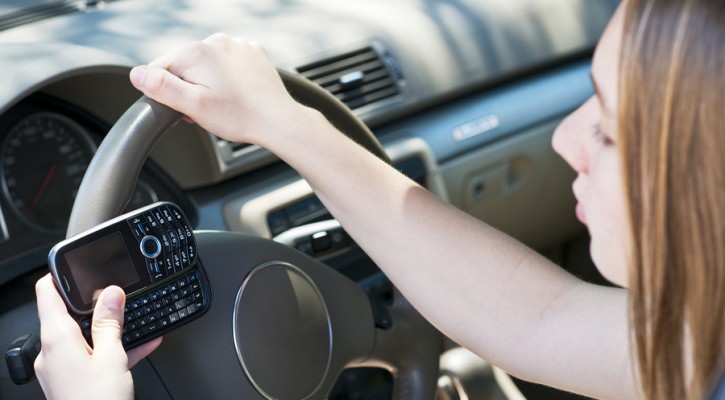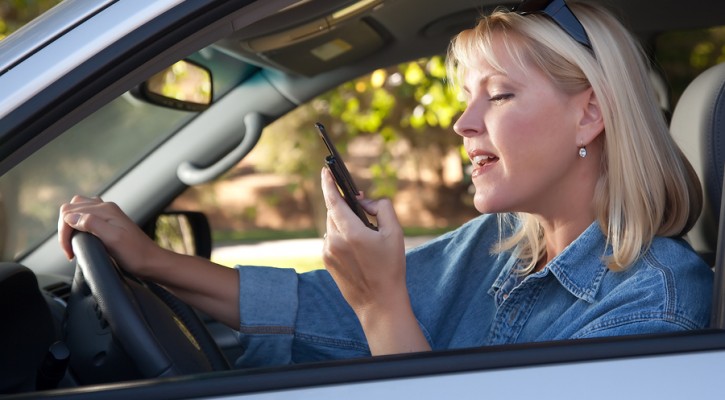Tag Archive: parents of teen drivers

Some Teen Safe Driving Choices Are Still Dangerous
December 17, 2015
Researchers at the Children’s Hospital of Philadelphia recently conducted a study to gauge teen attitudes on safe driving choices regarding cell phones. The researchers saw some encouraging signs but say there’s still a long way to go before cell phone use by teens while driving is a thing of the past.
To conduct their research, the researchers conducted several focus groups with 16 to 18 year old drivers. The questions asked of the teen drivers were designed to get an overall view of teen perceptions regarding cell phone use while driving with the intent of gathering information to help develop future interventions to reduce risky driving choices by teens.
According to the head researcher, Catherine McDonald, PhD, RN, it was encouraging to see that teens recognized that cell phone use, texting, and use of social media are dangerous behind-the-wheel. When asked what methods teens used to prevent the use of cell phones while driving, some teens listed methods such as turning off the cell phone or pulling off the road before making or answering a call. However, some teens listed choices such as waiting for a red light or until they were on familiar roads before diverting their attention to the cell phone.
While it’s good that they are considering ways to reduce their cell phone use, those choices such as waiting for red lights or familiar roads are still dangerous choices that take their eyes and mental attention off the road.
- Choosing to use hands-free communication devices has been shown to be no safer than the use of hand-held devices.
- A driver’s attention at red lights is important too. Not noticing that the light has turned green can hold up traffic behind and lead angry drivers to try to retaliate.
- Research shows that hands-free devices are still distracting for up to 27 seconds after hanging up.
- Waiting for familiar roads is a bad choice because most traffic collisions happen within 25 miles of home and at speeds below 45 mph. Drivers become complacent on those familiar roads and that leads to even more distractions.
According to the researchers, until more effective methods are developed to pry teens away from their cell phones while driving, parents are still the primary influence in promoting safer choices by teens. Setting a good example and insisting on strict rules for cell phone use while driving, parents can help keep their teens safe on the road.
Parents Don’t Understand The Dangers Of Teen Driving
December 3, 2015
A father’s grief following the death of his 17 year old son in a single car crash led him to write a book and produce a video to warn parents about the dangers of teen driving. The father, Tim Hollister, published his book Not So Fast: Parenting Your Teen Through the Dangers of Driving in 2013 and released the companion video on the ninth anniversary of his son’s death.
Teen drivers die at a disproportionate rate compared to all other age groups. In 2013, 1,691 teen drivers were killed and 177,000 were injured in car crashes. An additional 2,642 passengers, occupants of other vehicles, and pedestrians were killed in crashes involving a teen driver.
We have written articles on the dangers cited by Hollister countless times in this and other blogs but teens keep dying the same way month after month. Despite all the training and testing, teens die;
- Because their brains aren’t yet fully developed, leading them to take greater chances with no regard for the consequences.
- Most often in single vehicle crashes after losing control of their vehicle while speeding or driving distracted.
- While carrying other teen passengers who act as a distraction and whose presence, in some cases, lead the teen driver to show off by disregarding the safe driving rules.
- After drinking or using drugs.
- Because they text and drive with the belief that nothing bad will happen to them.
- Because they fail to wear seat belts.
Maybe, what it will take to get the word out to parents is the advice of a grieving father who knows now what he wishes he had known while his son was still alive.
The most important message is to not rely on driver’s ed, state tests, or common sense to keep your teen alive on the road. Parents must be constantly vigilant and set strict rules for their teen driver if they want them to survive into adulthood.
For more information visit: Not So Fast: Parenting Your Teen Through the Dangers of Driving

Teen Driving App Effective In Modifying Teen Driving Behavior
February 9, 2015
A teen driving app for smartphones, developed by the University of Minnesota’s HumanFIRST Laboratory, is showing a lot of promise as an effective tool to modify teen driving behavior and keep teen drivers safe on the road.
There have been a lot of apps and different products developed over the years with the same intent but the developers of this app claim that this is the first developed based on years of scientific research.
Funded with $2.5 million by the Minnesota Department of Transportation, the HumanFIRST Laboratory spent almost ten years examining the issues surrounding teen crashes and developing the app. Those studies were followed up by a year-long, in-vehicle study involving teens and their parents.
The teen driving app is known as the Teen Driver Support System (TDSS) and among other things, the app:
- Prohibits the use of cell phones while the vehicle is in motion except to make 911 calls.
- Warns the teen driver if he or she is speeding or running a stop sign or red light.
- Warns that the teen is driving aggressively.
- Warns the teen that parents will be notified if the dangerous driving behavior continues.
- Notifies parents via text message if the warnings fail to stop the dangerous driving behavior.
- Provides parents with a website that documents the teen’s driving behavior over a longer period of time.
In the in-vehicle study, cars belonging to teen drivers were outfitted with instrumentation to record their driving behavior and the teen drivers were divided into three groups:
- Drivers with no app (control group).
- Drivers with app that provided warnings but didn’t notify parents.
- Drivers with app that provided warnings and notified parents.
The teen drivers without the app showed a greater tendency to engage in distracting and risky behaviors such as, speeding more than seven mph over the posted speed limit and using the cell phone both for calls and texting while driving. The app that only provided warnings was highly effective in modifying teen driving behavior but, as might be expected, the app that provided both warnings and parental notification had the most dramatic effect on the teen’s driving behavior.
Both the teens and parents involved in the study gave the driving app high marks although, also to be expected, the teens weren’t as enthusiastic about the app as their parents:
- 60 to 75 percent of teens had a favorable opinion of the system.
- More than 90 percent of parents had a favorable opinion of the system and;
- 90 percent of parents would recommend the app to other parents of teen drivers.
While the TDSS teen driving app isn’t yet available for general use, the University of Minnesota’s Office for Technology Commercialization is studying the system and the team hopes it will be available for general use within a year.
Read more: App developed at U alerts teens, parents to risky driving
PowerPoint presentation with study results: Supporting New Teen Drivers During Independent Driving

Parents Text More Than Teens
October 16, 2014
Parents text more than teen drivers according to a newly released study sponsored by Straight Talk’s Safe Driver Initiative. The results of a poll of 1,000 licensed teens conducted by KRC Research revealed, among other things, that thirty-three percent of parents text as compared to twenty-four percent of teens.
Among their other findings
- Almost one-third of respondents admitted that they nearly were in a crash as a result of texting while driving in the past year.
- Forty-two percent of respondents said they were more likely to admit to pointing out others texting while driving than were likely to admit doing it themselves.
- For parents, texting and driving is the third most significant worry behind academic achievement and alcohol and drug use; and 88 percent of parents have had a frank discussion with their teens about texting and driving.
- More teens have had a frank discussion around texting and driving with their parents (74 percent) than have had discussions about teenage drinking (73 percent), drug use (71 percent), or sexual health (61 percent).
We wrote about the “Do as I say, not as I do!” phenomenon as far back as 2007. Teens look to their parents as their biggest influence and, when learning to drive, if they see their parents act in a way that, at the time, seems to have no negative consequences, the teen is more likely to follow that example.
Research has shown that more than eighty percent of crashes involved driver distraction within two or three seconds of the crash. If they want their teens to drive safely, parents need to put down the phone and be the role model for safe driving.
To learn more about the study, visit: Do As I Say, Not As I Do When It Comes To Texting And Driving

Study Says Teen Drivers in Arizona are Dangerous
December 15, 2006
A recent study by Arizona State University showed that, once again, fatal car accidents are the number one killer of Arizona children in 2005. During that year, 1,148 children under age 18 were killed. The study concluded that teen drivers accounted for much of the loss, which is a shame. Nationwide, car crashes are the top killer of teenagers, so this study is yet more proof that intervention and driver education is needed to help save teen lives.
This study was done by the Center for Health Information and Research at ASU, and about 250 people from the Arizona Child Fatality Review Teams reviewed statistics to come up with the study numbers. More shocking than the number of children killed is the fact that many of these deaths were preventable. The study also revealed that one third of the children, or 388, died under circumstances that were preventable.
ASU research center medical director Dr. Mary Rimsza states, “Parents need to supervise their kids and make sure they are using their restraints, driving safely and making sure they have enough driving experience.” Recommendations for parents include: setting consequences for teens (and enforcing them), showing support for the strengthening of graduated-licensing laws, and making sure their children are safe behind the wheel before allowing them to drive without an adult present.
With many teens involved in drug and alcohol abuse, reckless driving, and failing to wear seat belts, fatal car accidents are only going to continue. By being aware of the statistics, and taking action, parents can help save their child’s life and perhaps the lives of others as well. According to the numbers offered up by the ASU study, the lives of up to 400 children each year can be saved by taking preventative measures when it comes to letting your teens drive.
